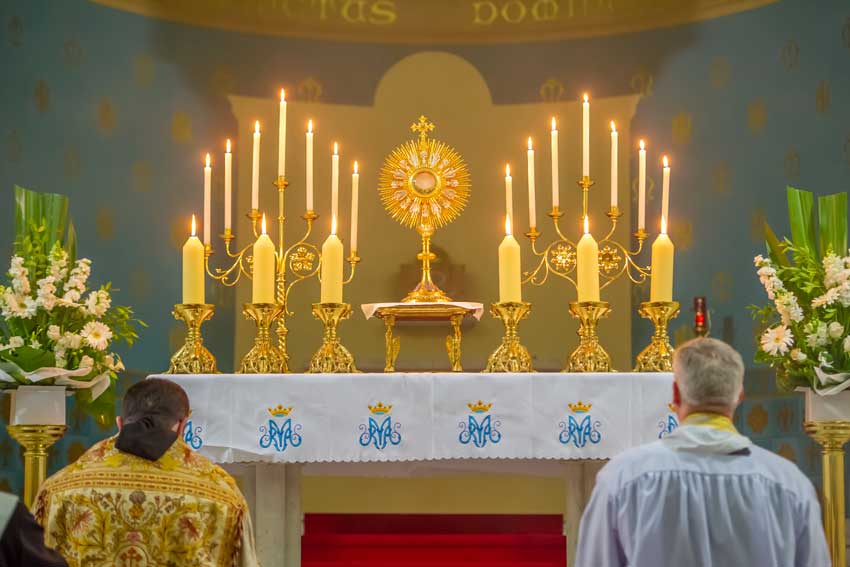
Dear Father, In recent years I have noticed that more and more parishes in Australia have some form of Eucharistic adoration. Do we know how this practice developed in the history of the Church?
Going back to what I wrote on the history of tabernacles, since the lay faithful kept the Eucharist in their homes during the persecutions of the first three centuries in order to receive Holy Communion, it is possible that they may have also prayed before it in some form of Eucharist adoration.
One of the first possible references to Eucharistic adoration comes in the life of St Basil, who died in 379 AD. In his monastery, he reserved some of the Blessed Sacrament from the Mass in a golden Columba, a dove-shaped vessel suspended above the altar, for giving Communion to the sick who were unable to attend the Mass. There the monks may have engaged in adoration of the Blessed Sacrament.
There was a custom of Eucharistic adoration in some Eastern Catholic Churches, which included singing psalms before the Blessed Sacrament in a covered diskos on the altar. This corresponds to the tradition of veiling from human eyes things deemed sacred.
In the 11th century, following a profession of faith required of Berengarius of Tours who had denied the real presence, there was a “Eucharistic renaissance” in Europe. The Franciscan archives credit St Francis of Assisi, who died in 1226, with starting Eucharistic adoration in Italy.
The first recorded instance of perpetual adoration began in Avignon, France, in 1226 to give thanks for the victory over the Albigensians in the siege of Avignon. It continued there practically uninterrupted until the French Revolution ended it in 1792.
In 1264, following the Eucharistic miracle of Bolsena, Italy, the previous year (cf. J. Flader, Question Time 1, q. 150), Pope Urban IV instituted the feast of Corpus Christi. He asked St Thomas Aquinas to write texts for the Mass and divine office of the feast.
These included the hymns O Salutaris Hostia and Tantum Ergo, which are still sung in benediction with the Blessed Sacrament.
In 1311, Pope Clement V extended the feast to the universal church, to be celebrated with a procession with the Blessed Sacrament (cf. J. Flader, Question Time 2, q. 270). From then on, processions with the Blessed Sacrament, a form of Eucharistic adoration, spread all over Europe.
In the 16th century, the Council of Trent, in answer to the Protestants’ denial of the Real Presence, encouraged Eucharistic adoration as a form of latria, the worship due only to God:
“The only-begotten Son of God is to be adored in the Holy Sacrament of the Eucharist with the worship of latria, including external worship. The sacrament, therefore, is to be honoured with extraordinary festive celebrations (and) solemnly carried from place to place in processions according to the praiseworthy universal rite and custom of the holy church. The sacrament is to be publicly exposed for the people’s adoration.”
Following the Council of Trent, St Charles Borromeo initiated the practice of placing the tabernacle in a higher, central location behind the main altar, to facilitate Eucharistic adoration. It was in the sixteenth century in Milan that the custom of “forty hours” devotion before the exposed Blessed Sacrament began, quickly spreading to other parts of Europe.
At that time too the practice of perpetual adoration began to be taken up widely, especially by religious institutes, among them the Blessed Sacrament Fathers, founded by St Peter Julian Eymard. In the 20th century the practice spread to parishes, and at the beginning of the 21st century, there were over 2,500 perpetual adoration chapels in Catholic parishes around the world.
Pope St John Paul II began perpetual adoration in the Blessed Sacrament chapel in St Peter’s Basilica in 1981.
As you say, Eucharistic Adoration has increased significantly in Australia in recent years, due in large measure to the work of the Society of Eucharistic Adoration, founded by Christine McCarthy, who went home to God in November, 2023. I am sure she will be richly rewarded for her work.
